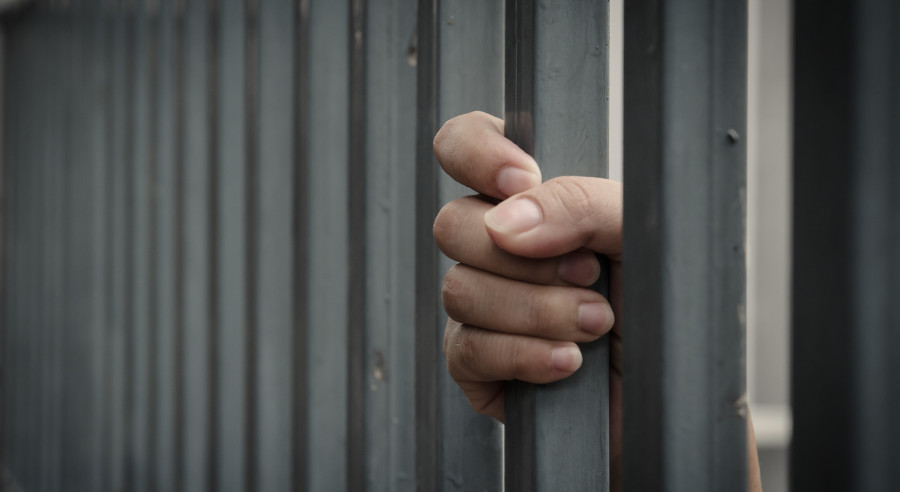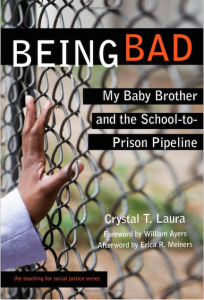 Crystal Laura is the author of Being Bad: My Baby Brother and the School-to-Prison Pipeline, a book that examines her little brother Chris’ long and convulsive journey from school to state prison. After a bright start in the early grades, he struggles in school. He is described as inattentive, or just disinterested. Eventually, he gets a disability diagnosis that maybe makes sense, or maybe not. By high school, he also gets arrested, more than once, on charges that include robbery and assault. Meanwhile, his mother is haunting principals' and doctors' offices, asking them to help her to help him. We meet him, in the book's prologue, in the Cook County jail.
Crystal Laura is the author of Being Bad: My Baby Brother and the School-to-Prison Pipeline, a book that examines her little brother Chris’ long and convulsive journey from school to state prison. After a bright start in the early grades, he struggles in school. He is described as inattentive, or just disinterested. Eventually, he gets a disability diagnosis that maybe makes sense, or maybe not. By high school, he also gets arrested, more than once, on charges that include robbery and assault. Meanwhile, his mother is haunting principals' and doctors' offices, asking them to help her to help him. We meet him, in the book's prologue, in the Cook County jail.
But make no mistake: This is not just the tale of one “bad kid.” Laura’s personal narrative is set within the broader issues of zero tolerance school policies and high-stakes testing, the mass incarceration of Black men in the U.S., and the value of love. Her book suggests that empowered educators can intervene in the so-called “school to prison pipeline. Laura, an assistant professor of education at Chicago State University (CSU) and co-director of CSU’s Center of Urban Research and Education, where she provides training to Chicago Public Schools teachers, recently talked to NEA Today.
A few of Chris’ teachers are described in the book—and almost all of them fail to do right by your brother. You write that you wish somebody, anybody, from his school, a teacher, a dean, a counselor, had said to him, ‘Wait. You matter to me!’ On the one hand, it’s disturbing to read that Chris never heard that. On the other, it sounds like you’re saying one person has power to make a difference and that’s a very heartening thing. Do you believe that?
Crystal Laura: I absolutely believe that. I absolutely believe that love, care, connectivity, and relationships are key. I don’t have to get all scholarly to say that. Chris feels like he can’t recollect one teacher who he felt comfortable being himself with, who he felt comfortable reaching out to for help. That is a complete travesty.
If Chris had a lifeline, somebody helping him to make connections between schooling and life, he would have had at least some flicker of imagination about what schooling and education could have been and meant for him.
I really hope people can see that. I hope people hear his story and recognize him in the young people that they see all day, those young people who seem difficult to inspire. I want people to get the message that ‘Okay, maybe that can be me. Maybe I can be the one. I can be the person who gets him excited about learning, about opportunity, about jobs.’
I don’t envision some big to-do here. I imagine somebody sitting down with a student and saying, ‘Hey, tell me about yourself.’
But I also want to be clear that there are bigger issues beyond individual people that also need to be addressed. There are larger, broader contexts in which all of our lives take shape.
When I read about the 9th-grade English teacher who was “clueless about what made Chris tick,” and who never understood he has the “heart of an artist,” I wondered if maybe she was too busy getting ready for her city and state’s high-stakes standardized tests. Is there a relationship between high-stakes testing, and the kill-and-drill curriculum that often comes with it, and the school-to-prison pipeline?
CL: Certainly the inability to take the time to learn the nuances and ticks of each individual student has everything to do with the constrained context in which testing is the regime. When everything teachers do is connected to their evaluations, and everything about their evaluations is connected to testing, they want to know how they can create the space to get to know their students on an everyday basis.
But there are people who have and share resources to enable radical, progressive, liberal teaching, even within the current neo-liberal context. Part of what I do is point to people who do this: Teachers 4 Social Justice, for example. The other thing I do is to ask people to think about themselves as ‘the one,’ the one person who can love this student.
You write that love isn’t an emotion, but an action. ‘Love is the action we take to enhance or alter our own or somebody else’s well-being; love is what we do to make people happier and healthier.’ What does the act of love look like in a classroom?
CL: I don’t want to rule out the more effective understandings of love — certainly it can be expressed in an emotional way, showing care, and Chris also needed that. But love as an action goes back to this sense of relationships and connectivity.
Here’s an example that people can hang onto: When students are not living up to your expectations — Chris’ example is cursing in the classroom — he said, ‘Don’t send me out of the classroom. I’m not learning anything going out of the classroom. I would prefer somebody sitting me down and saying, there are lots of words in the dictionary, and this is a place of learning, so let’s learn them.’
His point was to use these teaching moments to act on the student’s behalf, to show that you actually want that student here with you.
This idea of love as an action really can have profound impact on how we approach instances of harm, and our efforts to repair and restore. That’s part of the reason I’m really interested in restorative approaches. They sure do beat the other option, which is saying ‘I’m done with you.’
 You identify a few factors that “nudge” students out the door. One is excessive discipline, which disproportionately affects Black boys, and the other is being labeled as “disabled,” which also disproportionately affects Black boys. Is there a relationship between special education and the school-to-prison pipeline?
You identify a few factors that “nudge” students out the door. One is excessive discipline, which disproportionately affects Black boys, and the other is being labeled as “disabled,” which also disproportionately affects Black boys. Is there a relationship between special education and the school-to-prison pipeline?
CL: As a country, we have become obsessed with isolating people. We can see that very starkly in the growing prison population — we have 25 percent of the world’s prisoners and only 5 percent of the world’s population. And we know that the people who are locked up are grossly undereducated by every measure: lower literacy rates, lower graduation rates, greater prevalence of disabilities… There is some eerie relationship between schools and prisons.
We need to understand the larger context, which is that we accept and depend on the idea that this is the way, to isolate people who rub up against our sensibilities. It’s a paradigm, a paradigm of of punishment. As Americans, we are so infatuated with punishment.
With that context in mind, it doesn’t surprise me at all that in schools, especially with kids who rub up against our sensibilities, who we think are bad, that we seek to isolate them. With that way or thinking in mind, it’s no surprise we consistently overuse or misuse special education categories, especially for people of color, especially for males. If you use the prison nation as a backdrop, special education, race and incarceration seem to gel together.
In addition to the ways that individuals can help, say, by being the ‘one person’ who makes a difference, are there policy solutions?
CL: Here in Chicago, we’re working on legislation to get mandatory restorative justice training for Chicago Public Schools teachers. What’s happening here, and what happened with the zero-tolerance legislation in Denver, is definitely moving in the right direction. It’s getting more people into the conversation. And the more people saying we need to try other things, we need to address this issue in creative ways, we need to think about love, we need to shift the paradigm, the more we will build momentum for a different policy context.
How’s Chris doing?
CL: He’s doing. He’ll be gone for several years, but he’s as best as can be under the circumstances. He’s excited the book is out, and he’s excited that people are talking about it.









